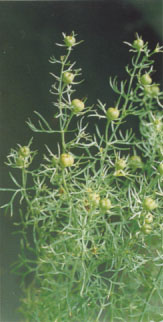- Zygophyllaceae - Western Asia to India
 |
Growing from a perennial woody rottock, Peganum harmala is a bright-green, densely foliaged, herbaceous succulent. Although it's smooth many-branched stems may have a spread of four feet or more, the plant is rarely over two feet tall and generally appears round and bushy in habit. Its leaves are two inches long, born singly and finey diided into long narrow segments.
Each year between June and August, P. harmala produces many single white conspicuous flowers. Measurg one to one and one-half inches across, these relatively large and showy blooms have five oblong-elptic petals as well as five narrow sepals of slightly longer length. Each flower has the potentialtodevelop into a fruit--a leathery, three-- valved seed capsule that stands erect on its stalk. Eac casule measures about three-eighths inch in diameter and contains more than fifty dark-brown, angular seeds.
The seeds, as well as the roots, of P. harmala contain a mixture of the harmala alkaloids, armine and harmaline. These unusual alkaloids are psychoactive derivatives of B-carboline, When admnstered to man, the harmala alkaloids are serotonin antagonists, CNS stimulants, hallucinogens and extremely potent, short term MAO inhibitors. Interestingly enough though, neither harmine, harmaline nor Peganum harmala is included in the Federal Controlled Substance Act. Present at 3% by dry weight, the harmala alkaoids may be extracted from the seeds and roots of P. harmala and purified as crystalline bases. Hasenratz described this process in 1927.
P. harmala, or Syrian Rue, is the plant from which harmine was first isolated, as well as a source of harmaline and tetrahydroharmine. Total beta-Carboline content runs almost 4% by weight in the seeds of Syrian Rue. These alkaloids occur in roughly the same proportions as in B. caapi. Ten grams of Syrian Rue seeds provide about 400mg of total beta-Carbolines, about that amount in a typical dose of ayahuasca.
Syrian Rue grows in semi-arid conditions. It originated in Central Asia, and is held in high esteem throughout Asia Minor as a medicinal, aphrodisiac and dye plant. There is no solid historical evidence of ritual or religious use. It is sometimes known as "ruin weed" since it often grows on the tells covering the ruins of ancient cities in the Near East. It now grows wild in Eurasia and has recently been spread to Texas, Nevada, New Mexico and Southern California.
Traditional Preparation
Reportedly, an especially effective smoking mixture can be made from 15 grams of the seeds and the juice of a lemon. The seeds were ground with a mortar and pestle, and then put into a boiling pot over and open flame with the juice of 1 lemon added. Thsi was then boiled down until a resinous paste was left. It was then mixed with tobacco for a smoke that was both inebriating and a potent aphrodisiac as well.
In Morocco, the seeds are simply added to wine for harmala wine, or they are powdered to make a snuff that is supposed to cause a "clear mind" as some reports explain.
Up to 20 grams of the seeds have been ground up and eaten in attempts to gain pshychoactive effects, but this can have very toxic consequences. Yes, they can reportedly be hallucinogenic in large doses, but since it's also a powerful MAO inhibitor, it can turn food poisonous. Typically, when used as an MAO inhbitor, only 3 - 4 grams are ground up and extracted into water, but are rarely eaten.
http://www.entheology.org/